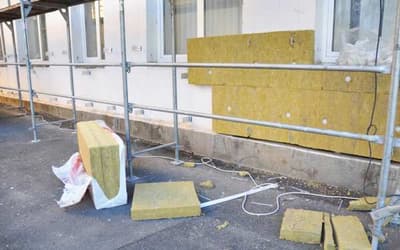- Help & Advice /
- Everything you need to know about External Wall Insulation
Everything you need to know about External Wall Insulation
Wondering if external wall insulation could be suitable for your property?

What is external wall insulation?
External solid wall insulation (EWI) is a layer of insulating material attached to the outside walls of a building and coated with protective render or cladding. By reducing heat loss in cold weather and heat gain in warm weather, EWI creates a much more comfortable living environment and reduces heating costs.
Do I need planning permission?
Planning permission is generally required only if the property is within a conservation area or a designated area
Is my property suitable?
Solid walls are found in most houses built before the 1920s If you live in a mid-terraced property, it is possible to install EWI even if your neighbours on either side choose not to by providing a ‘stop end’ at the edge of your boundary. Solid wall insulation may be suitable for a variety of wall types such as brick, stone, steel-framed and concrete construction.
Will there be any noise?
Installation involves drilling, attaching insulation boards and pebble-dashing, so there will be some noise at these times.
How much disruption will there be? Will there be scaffolding?
EWI is a significant undertaking that inevitably involves a degree of disruption. Your installer should make you aware of any particular issues but things to consider include: Garden access may be required and boundary walls may need to be adapted or removed. Scaffolding may need to be erected, and a space found for a skip and storage space for materials. External fittings such as pipework and satellite dishes may need to be temporarily removed. It may be necessary to extend window sills so they protrude beyond the cladding. Windows can change in appearance, as the insulation needs to extend into the window recess.
How long will it take to install?
The length of time taken to install EWI will depend on the size of the property but, as a guide, a typical 3-bedroom semi-detached house will take just a couple of weeks. This includes all preparatory works such as extending flues and overflow pipes etc. and reinstatement of the rain water pipes along with installation of the system, application of materials, the finish and all drying times.
How long will it last?
EWI is a long-term investment. Most system designers will be able to provide a warrantee of, or in excess of 25 years
What about my security alarm?
We recommend that your security alarm company attend to remove and reinstate. Service connection may be lost for the duration of works.
What about my satellite dish or TV ariel?
As you might expect, items fastened to the external wall surfaces of your home will need to be removed before the insulation is fitted and this includes satellite dishes and aerials. Satellite dishes will be removed during the works and temporarily attached to the scaffolding, where they will continue to work. There may be a short time when you won’t have access to your TV service in between the scaffolding work and the contractor will make the temporary adjustment. Other items that may need to be moved are alarm boxes and external lights.
What will happen to pipes etc. that are attached to my outside walls?
Essential items will be extended to accommodate your new insulation. This includes: rainwater and soil pipes, flues, window and door sills, garden taps. If the standard extension option is unsuitable for any essential item attached to your home, then the surveyor will discuss alternative solutions with you and will ensure these meet safety requirements. All air vents and gas combustion vents will be maintained for the duration of works. Decorative fixtures and fittings, such as hanging baskets or door canopies can be accommodated but this may involve a surcharge. To replace such items, fixings must be installed under the new wall covering before they can be re-attached.